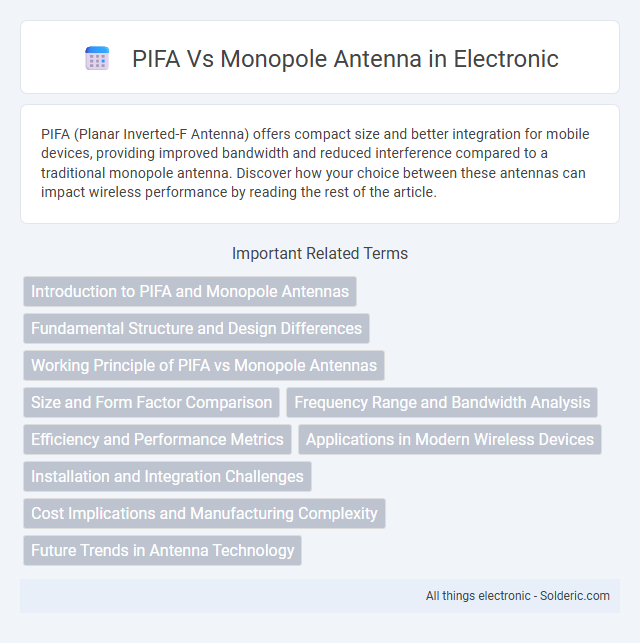PIFA (Planar Inverted-F Antenna) offers compact size and better integration for mobile devices, providing improved bandwidth and reduced interference compared to a traditional monopole antenna. Discover how your choice between these antennas can impact wireless performance by reading the rest of the article.
Comparison Table
| Feature | PIFA Antenna | Monopole Antenna |
|---|---|---|
| Type | Planar Inverted-F Antenna | Vertical Monopole Antenna |
| Size | Compact, low-profile | Typically larger, requires ground plane |
| Radiation Pattern | Directional to semi-omnidirectional | Omnidirectional in azimuth |
| Bandwidth | Narrow to moderate | Wide bandwidth possible |
| Efficiency | Moderate, affected by ground plane size | Generally high |
| Applications | Mobile devices, wireless LAN, compact integration | Base stations, vehicle antennas, general RF transmission |
| Polarization | Mostly linear, can be adjusted | Linear, vertical polarization |
| Ground Plane Requirement | Partial or small ground plane needed | Large ground plane essential |
| Cost | Typically higher due to design complexity | Lower, simpler construction |
Introduction to PIFA and Monopole Antennas
PIFA (Planar Inverted-F Antenna) and monopole antennas are widely used in wireless communication due to their compact size and efficient performance. PIFA features a grounded plane and a radiating patch, offering improved bandwidth and reduced interference compared to traditional monopole designs, which rely on a single radiating element above a ground plane. Your choice between PIFA and monopole antennas depends on specific application requirements such as size constraints, frequency range, and radiation pattern preferences.
Fundamental Structure and Design Differences
PIFA (Planar Inverted-F Antenna) features a compact, low-profile design with a vertical radiating element shorted to the ground plane and a horizontal top plate, optimizing space for mobile devices. Monopole antennas consist of a single vertical conductive element mounted perpendicular to a ground plane, relying primarily on its length for resonance and radiation. The PIFA's folded structure allows for reduced antenna size and improved impedance matching compared to the simpler, often larger monopole antenna.
Working Principle of PIFA vs Monopole Antennas
PIFA (Planar Inverted-F Antenna) operates by using a shorted patch and ground plane to create a resonant cavity, enabling compact size and effective impedance matching. Monopole antennas function as a quarter-wavelength radiator above a conductive surface, relying on image theory to generate their radiation pattern. Your choice between PIFA and monopole antennas depends on specific requirements for size, bandwidth, and integration within devices.
Size and Form Factor Comparison
PIFA antennas offer a more compact and low-profile form factor compared to monopole antennas, making them ideal for space-constrained applications like mobile devices and wearable technology. The planar structure of PIFA enables efficient integration onto circuit boards, reducing the overall device thickness. In contrast, monopole antennas generally require larger vertical space due to their protruding designs, which can increase the device's height and limit portability.
Frequency Range and Bandwidth Analysis
PIFA antennas typically offer a narrower bandwidth compared to monopole antennas but excel in providing efficient performance within specific frequency ranges such as those used in mobile communications (e.g., 1.8 GHz to 2.5 GHz). Monopole antennas generally support a wider frequency range and exhibit broader bandwidth characteristics, making them suitable for applications requiring multi-band or ultra-wideband performance. Your choice depends on whether you prioritize compact size and frequency-specific efficiency (PIFA) or broader frequency coverage and bandwidth (monopole).
Efficiency and Performance Metrics
PIFA antennas typically offer higher efficiency and better performance metrics such as gain and bandwidth compared to monopole antennas, especially in compact and portable devices. Your choice depends on application requirements, as PIFAs provide improved radiation efficiency and reduced interference in limited spaces, while monopoles are simpler with broader frequency coverage but lower efficiency in miniaturized designs. Understanding these differences ensures optimal antenna performance for your specific wireless communication needs.
Applications in Modern Wireless Devices
PIFA antennas are widely used in compact mobile devices due to their low profile and efficient performance in limited space, making them ideal for smartphones and wearables. Monopole antennas offer broader bandwidth and simpler design, which suits applications like Wi-Fi routers and vehicle communication systems. Your choice depends on device size constraints and required frequency range, ensuring optimal wireless connectivity in modern applications.
Installation and Integration Challenges
PIFA antennas offer compact, low-profile designs that simplify integration into mobile devices by minimizing space requirements and reducing interference with other components. Monopole antennas require careful positioning and often need larger ground planes, complicating installation in compact enclosures and potentially impacting device aesthetics. Your choice between PIFA and monopole antennas depends on balancing installation constraints with performance needs in the device's intended environment.
Cost Implications and Manufacturing Complexity
PIFA antennas typically exhibit lower manufacturing complexity due to their compact, planar design that integrates well with printed circuit boards, reducing assembly steps and material costs. Monopole antennas often require longer elements and additional supporting structures, increasing production expenses and complicating mass manufacture. Your choice between PIFA and monopole antennas can significantly impact budget and production timelines based on these cost and complexity factors.
Future Trends in Antenna Technology
PIFA antennas are expected to evolve with enhanced bandwidth and miniaturization, making them ideal for compact 5G and IoT devices, while monopole antennas will continue to benefit from advanced materials to improve efficiency and gain in emerging mmWave communications. Integration of AI-driven adaptive tuning and smart beamforming technology will accelerate the capabilities of both PIFA and monopole antennas, optimizing your wireless signal in dynamic environments. Research into flexible and wearable antenna designs will also drive future trends, enabling seamless connectivity for next-generation mobile and wearable electronics.
PIFA vs monopole antenna Infographic

 solderic.com
solderic.com